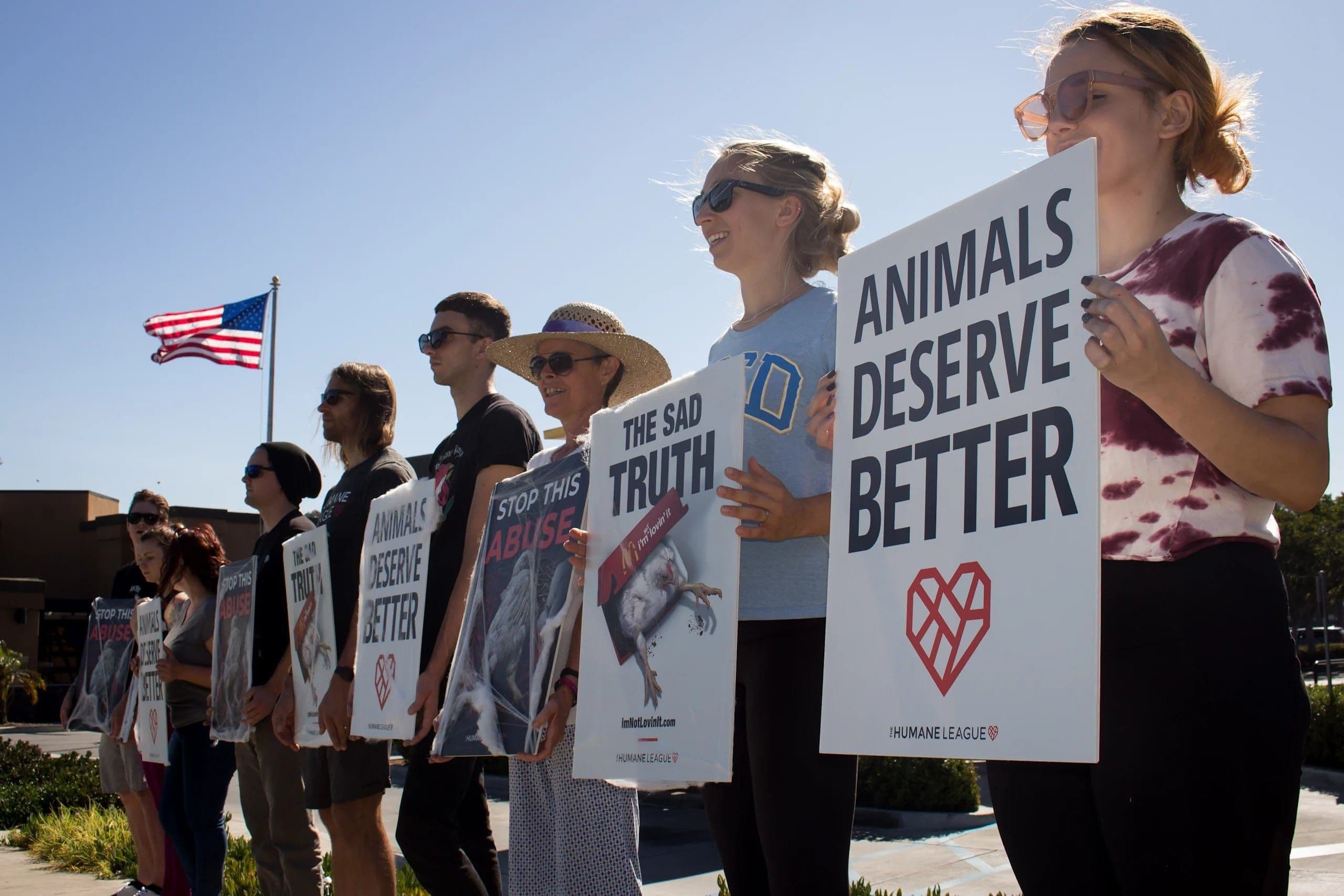Corporate Campaigns for Animal Welfare

▲ Photo from The Humane League
Related research
This is an executive summary of our investigation into corporate campaigns for animal welfare
Each year, billions of animals are raised in industrial factory farming, where they live in extremely poor conditions, and are ultimately killed in painful ways. This report provides an overview of the problem and discusses what philanthropists can do to tackle it.
Animal farming
At any point in time, there are roughly 30 billion farmed vertebrate land animals in the world, including 23 billion chickens. The majority of those live in factory farms: for instance, a recent estimate suggests roughly 90% of global egg production uses cage systems.
Factory farming is very bad for animal welfare. In the US, standard industry practice is to provide egg-laying hens living in battery cages with 430 to 560 cm2 of space. For context, A4 paper and US letter paper are roughly 600 cm2. Broiler chickens (chickens used for meat consumption) have been genetically selected for fast growth and efficient production, which is associated with major animal welfare issues, such as skeletal problems, footpad dermatitis, and chronic hunger. Between 2.5 and 7 billion male chicks of egg-laying strains are culled each year, usually within a day of hatching, because they are not economically profitable.
Despite the scale of the problem, and the severity of its effects on animals, relatively little funding is directed towards helping farmed animals. In the US, only 0.03% of total philanthropic funding goes towards farmed animals.
Prioritizing interventions
In this report we focus on what we had some prior reason to believe was a highly promising animal welfare intervention, and test the extent to which these initial judgments stand up to scrutiny. Unlike our usual methodology, we did not conduct a comprehensive assessment of all available programs and organizations working in the space. This is because our aim is to provide timely advice for donors, because farmed animal welfare is a very promising field that many donors have expressed a desire for recommendations in. Conducting a more complete investigation remains a likely priority for the future.
Corporate campaigns
The intervention we focus on is corporate campaigns. Corporate campaigns seek to shift corporate practices towards systems that improve animal welfare, employing a variety of strategies, including supporting aligned stakeholders or offering technical assistance, and launching social media campaigns against companies that refuse to engage.
Case study evaluated
To assess the effectiveness of this intervention, we focus on corporate campaigns targeting battery cages in the US as a case study. As of early 2016, over 200 companies had committed to implement cage-free systems within a ten-year timeline. Collectively, these commitments are estimated to spare 225 million hens from battery cage confinement each year. An assessment of timelines and interviews of stakeholders suggests that corporate campaigns were instrumental to obtaining commitments to discontinue battery cage systems in the US.
Benefits for animals
We then assess whether the policies targeted by corporate campaigns are likely to bring about improvements in animal welfare. We focus on three policies. The first policy consists of shifting the housing of egg-laying hens from battery cages to aviaries. In battery cages, animals live in tiered cages and are tightly stacked together. In aviaries, birds live on platforms that are stacked at different heights and provide on average 90% more space per bird than battery cages. We think it is likely that aviaries are better for animal welfare than battery cage systems.
The second policy is ending chick culling. The most promising way of doing so involves avoiding the birth of male chicks by employing technologies that determine the sex of fertilized eggs before the chick develops. We are confident that, if successful, this would end the suffering associated with chick culling.
The third shift consists of adopting policies that aim to improve the welfare of broiler chickens. Corporate campaigns focusing on the welfare of broilers have promoted four types of changes: increased amount of space, improved quality of environment (including access to perches and natural light), selecting breeds that would avoid common welfare problems, and adopting less harmful slaughtering practices. After reviewing the literature on those changes, we believe that most of these interventions would likely bring about improvements in the welfare of broiler chickens.
It’s important to note that accurately understanding how the wellbeing of chickens is affected by these policies is very complex. This can lead to differing conclusions about whether a policy change is positive and has in this instance lead to some animal advocacy groups advocating against the policies in question. This is because there is a low yet non-negligible chance that shifting to aviaries and employing new broilers breeds actually has negative effects on animal welfare. Our subjective estimate is that the probability of THL-supported policies causing harm is between 5 and 10%. We report THL’s response to these concerns in Appendix 3 below. Our best guess remains that these reforms will bring about significant benefits for animals. Nonetheless, donors should be aware of the potential risk. Donors averse to this risk may decide to wait to donate until we complete a wider investigation of animal welfare interventions.
Likelihood of success
Large uncertainties remain in the likelihood that campaigns will successfully bring about the desired changes. This is because commitments are not legally binding, and, in the case of broiler chickens and chick culling, success relies on the adoption of technologies that are yet to be developed or made commercially available. Even taking these uncertainties into account, however, the expected benefits from the campaigns are still extremely large, mainly because of the large number of animals that would benefit from the improvements.